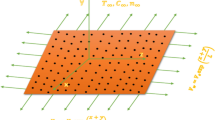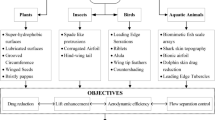Abstract
In nature and engineering, a uniform flexible beam with point buoyancy is common, such as water lily and stem, kelp, buoy and mooring, and deep-sea flexible riser. Response to a flexible beam with point buoyancy is more complicated than that of a flexible beam. Therefore, this paper conducts theoretical numerical and water tank drag experimental research on the drag reduction problem of flexible beams with point buoyancy. First, a governing equation with point buoyancy is established. Then, an explicit iterative numerical method is proposed to solve large geometric nonlinear differential equations. Finally, numerical and experimental methods studied the drag reduction phenomenon of flexible beams with point buoyancy. The results show that the reconfiguration shape of flexible beam with point buoyancy is no longer self-similar, and there are locally bending points in beam deformations. It is found that the Vogel exponent curve fluctuates due to the non-self-similarity of the deformation shape. Moreover, as the buoyancy gets more excellent, the fluctuation range of Vogel values becomes more profound.


















Similar content being viewed by others
Data availability
The data of this paper can be provided according to the reader's requirements.
References
Alben S, Shelley M, Zhang J (2002) Drag reduction through self-similar bending of a flexible body. Nature 420(6915):479–481
Alben S, Shelley M, Zhang J (2004) How flexibility induces streamlining in a two-dimensional flow. Phys Fluids 16(5):1694–1713
Batchelor CK, Batchelor G (2000) An introduction to fluid dynamics. Cambridge University Press
Blevins, Robert D (1984). Applied fluid dynamics handbook. Van Nostrand Reinhold Co., Nostrand
Chakrabarti SK (2015) The Theory and Practice of Hydrodynamics and Vibration:, vol 20. World Scientific Pub Co Inc, Singapore
De Langre E (2008) Effects of wind on plants. Annu Rev Fluid Mech 40:141–168
De Langre E, Gutierrez A, Cossé J (2012) On the scaling of drag reduction by reconfiguration in plants. Comptes Rendus Mécanique 340(1–2):35–40
De Langre E (2019) Plant vibrations at all scales: a review. J Exp Bot 70(14):3521–3531
Denny M (1994) Extreme drag forces and the survival of wind-and water-swept organisms. J Exp Biol 194(1):97–115
Etnier SA, Vogel S (2000) Reorientation of daffodil (Narcissus: Amaryllidaceae) flowers inwind: drag reduction andtorsional flexibility. Am J Bot 87(1):29–32
Gillies J, Nickling W, King J (2002) Drag coefficient and plant form response to wind speed in three plant species: Burning Bush (Euonymus alatus), Colorado Blue Spruce (Picea pungens glauca.), and Fountain Grass (Pennisetum setaceum). J Geophys Res Atmos 107(D24): ACL 10–11-ACL 10–15.
Gosselin F, de Langre E, Machado-Almeida BA (2010) Drag reduction of flexible plates by reconfiguration. J Fluid Mech 650:319–341
Henriquez S, Barrero-Gil A (2014) Reconfiguration of flexible plates in sheared flow. Mech Res Commun 62:1–4
Koehl M (1984) How do benthic organisms withstand moving water? Am Zool 24(1):57–70
Koizumi A, Motoyama J-I, Sawata K, Sasaki Y, Hirai T (2010) Evaluation of drag coefficients of poplar-tree crowns by a field test method. J Wood Sci 56(3):189–193
Leclercq T, de Langre E (2016) Drag reduction by elastic reconfiguration of non-uniform beams in non-uniform flows. J Fluids Struct 60:114–129
Luhar M, Nepf HM (2011) Flow-induced reconfiguration of buoyant and flexible aquatic vegetation. Limnol Oceanogr 56(6):2003–2017
Martone PT, Kost L, Boller M (2012) Drag reduction in wave-swept macroalgae: Alternative strategies and new predictions. Am J Bot 99(5):806–815
Puijalon S, Bornette G, Sagnes P (2005) Adaptations to increasing hydraulic stress: morphology, hydrodynamics and fitness of two higher aquatic plant species. J Exp Bot 56(412):777–786
Rudnicki M, Mitchell SJ, Novak MD (2004) Wind tunnel measurements of crown streamlining and drag relationships for three conifer species. Can J for Res 34(3):666–676
Sand-Jensen K (2003) Drag and reconfiguration of freshwater macrophytes. Freshw Biol 48(2):271–283
Tickner EG, Sacks AH (1969) Engineering simulation of the viscous behavior of whole blood using suspensions of flexible particles. Circ Res 25(4):389
Vogel S (1989) Drag and Reconfiguration of Broad Leaves in High Winds. J Exp Bot 40(8):941–948
Vogel S (2015) Drag and Flexibility in Sessile Organisms1. Integr Comp Biol 24(1):37–44
Zhu L (2008) Scaling laws for drag of a compliant body in an incompressible viscous flow. J Fluid Mech 607:387–400
Zhu L, Peskin CS (2007) Drag of a flexible fiber in a 2D moving viscous fluid. Comput Fluids 36(2):398–406
Acknowledgements
This work was supported by the Strategic Priority Research Program of the Chinese Academy of Sciences (Grant No. XDA22000000). The authors are grateful for the assistance of the anonymous reviewers.
Author information
Authors and Affiliations
Contributions
Jixiang Song: Methodology, Software, Data curation, Writing-Original draft preparation. Weimin Chen: Conceptualization, Validation, Visualization, Supervision, Investigation. Shuangxi Guo: Supervision, Validation. Dingbang Yan: Supervision, Validation. All authors reviewed the manuscript.
Corresponding author
Ethics declarations
Conflict of interest
The authors declare that they have no conflict of interest.
Additional information
Publisher's Note
Springer Nature remains neutral with regard to jurisdictional claims in published maps and institutional affiliations.
Rights and permissions
Springer Nature or its licensor (e.g. a society or other partner) holds exclusive rights to this article under a publishing agreement with the author(s) or other rightsholder(s); author self-archiving of the accepted manuscript version of this article is solely governed by the terms of such publishing agreement and applicable law.
About this article
Cite this article
Song, J., Chen, W., Guo, S. et al. Numerical and experimental studies on reconfiguration of flexible beam with point buoyancy. J. Ocean Eng. Mar. Energy 10, 335–349 (2024). https://doi.org/10.1007/s40722-024-00315-3
Received:
Accepted:
Published:
Issue Date:
DOI: https://doi.org/10.1007/s40722-024-00315-3




